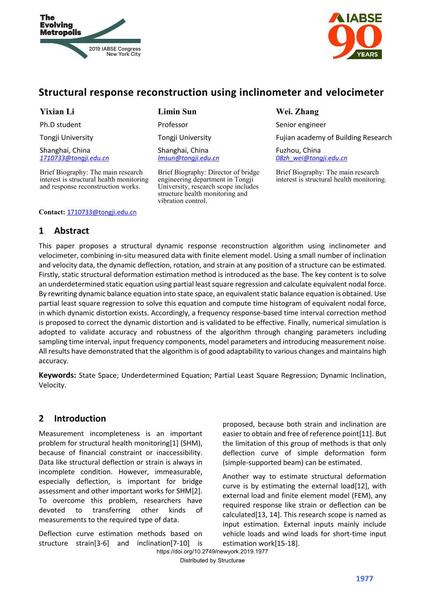Structural response reconstruction using inclinometer and velocimeter

|
|
|||||||||||
Détails bibliographiques
| Auteur(s): |
Yixian Li
(Tongji University)
Limin Sun Wei Zhang (Fujian academy of Building Research) |
||||
|---|---|---|---|---|---|
| Médium: | papier de conférence | ||||
| Langue(s): | anglais | ||||
| Conférence: | IABSE Congress: The Evolving Metropolis, New York, NY, USA, 4-6 September 2019 | ||||
| Publié dans: | The Evolving Metropolis | ||||
|
|||||
| Page(s): | 1977-1983 | ||||
| Nombre total de pages (du PDF): | 7 | ||||
| DOI: | 10.2749/newyork.2019.1977 | ||||
| Abstrait: |
This paper proposes a structural dynamic response reconstruction algorithm using inclinometer and velocimeter, combining in-situ measured data with finite element model. Using a small number of inclination and velocity data, the dynamic deflection, rotation, and strain at any position of a structure can be estimated. Firstly, static structural deformation estimation method is introduced as the base. The key content is to solve an underdetermined static equation using partial least square regression and calculate equivalent nodal force. By rewriting dynamic balance equation into state space, an equivalent static balance equation is obtained. Use partial least square regression to solve this equation and compute time histogram of equivalent nodal force, in which dynamic distortion exists. Accordingly, a frequency response-based time interval correction method is proposed to correct the dynamic distortion and is validated to be effective. Finally, numerical simulation is adopted to validate accuracy and robustness of the algorithm through changing parameters including sampling time interval, input frequency components, model parameters and introducing measurement noise. All results have demonstrated that the algorithm is of good adaptability to various changes and maintains high accuracy. |
||||
